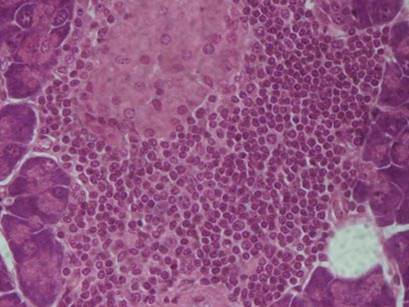An early step in type 1 diabetes development

An American-Australian research team has identified what may be the initial target of the immune response that causes type 1 diabetes. Published in the journal Science, the discovery provides a plausible explanation for why diabetes patients’ immune systems mistakenly destroy the body’s cells.
When the immune system is functioning properly, it protects us against bacteria and viruses that might make us sick. But in people with autoimmune diseases, the immune system attacks healthy parts of the body. For type 1 diabetes patients, the cells that secrete insulin (beta cells), located in islets within the pancreas, are in the firing line.
Researchers have now shown that fragments of two different beta-cell proteins, called peptides, join together to create a hybrid peptide, which is recognised as foreign by the immune system’s T cells. The University of Colorado’s Professor Kathryn Haskins and Assistant Professor Thomas Delong identified these hybrid peptides in a mouse model of type 1 diabetes.
The scientists turned to Dr Stuart Mannering, and his team from St Vincent’s Institute of Medical Research (SVI), to determine if their findings held true in humans. Dr Mannering’s team was the first in the world to isolate human T cells from the pancreas of organ donors who had type 1 diabetes and had been using these T cells to dissect what they recognise and respond to within the human beta cells.
“When we tested the hybrid peptide identified by the American group with T cells from human islets from organ donors who had type 1 diabetes, some of the T cells responded vigorously,” Dr Mannering said. “It is like a police line-up. The T cells only recognise hybrid peptides that they have met before. The fact that the T cells reacted to the hybrid peptide meant that we were on the right track.”
SVI Director Professor Tom Kay said the team’s discovery “confirms that insulin itself is likely to be the main target of the immune system in type 1 diabetes, but in an unexpected way”. If the hybrid peptides do indeed turn out to be the targets of the initial immune response, the researchers will be able to start working on strategies to use them to halt the disease.
“This work opens up an exciting new line of research that could lead to practical application in both early diagnosis and treatment,” Professor Kay said.
Babies of stressed mothers likely to get their teeth earlier
Maternal stress during pregnancy can speed up the timing of teeth eruption, which may be an early...
Customised immune cells used to fight brain cancer
Researchers have developed CAR-T cells — ie, genetically modified immune cells manufactured...
Elevated blood protein levels predict mortality
Proteins that play key roles in the development of diseases such as cancer and inflammation may...





